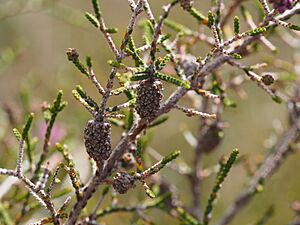Small-leaved beaufortia facts for kids
Quick facts for kids Small-leaved beaufortia |
|
|---|---|
 |
|
| Beaufortia micrantha growing near Hopetoun | |
| Scientific classification | |
| Genus: |
Beaufortia (plant)
|
| Species: |
micrantha
|
| Synonyms | |
|
Melaleuca micrantha (Schauer) Craven & R.D.Edwards |
|
Beaufortia micrantha, often called the small-leaved beaufortia or little bottlebrush, is a cool plant from the Myrtaceae family, which is the same family as myrtle trees. It only grows in the south-west part of Western Australia. This plant is a small, bushy shrub with tiny leaves that hug its stems. It also has lots of pretty purple or pinkish flowers.
Contents
What it Looks Like
Beaufortia micrantha is a small, bushy plant. It usually grows to be about 0.5 metres (2 ft) tall, which is about half the height of an adult.
Leaves and Flowers
The leaves of this plant are shaped like small triangles. They are only about 1–2 millimetres (0.04–0.08 in) long. The top part of each leaf is pressed flat against the stem. Sometimes, the leaves even overlap each other. Another plant, Beaufortia empetrifolia, has similar leaves, but they don't hug the stems as much.
The flowers are usually pinkish-red or purple. They grow in round bunches that are about 10 millimetres (0.4 in) across and 15 millimetres (0.6 in) long. These flower bunches grow at the ends of the branches. The branches keep growing even after the flowers bloom!
Each flower has 5 sepals (small leaf-like parts that protect the bud) and 5 petals (the colorful parts). It also has 5 groups of stamens (the parts that make pollen). Each stamen group has 3 to 5 stamens. These groups are about 6–10 millimetres (0.2–0.4 in) long. The free parts of the stamens are another 5–10 millimetres (0.2–0.4 in) long.
When it Blooms and Grows Fruit
Beaufortia micrantha can flower in most months of the year. However, it blooms the most from September to November. After the flowers, the plant grows fruits. These fruits are woody capsules. They are about 25–35 millimetres (0.98–1.4 in) long and 6–10 millimetres (0.2–0.4 in) wide. They are packed very closely together on the plant.
Naming the Plant
The plant Beaufortia micrantha was first officially described in 1843. This was done by a scientist named Johannes Conrad Schauer. He wrote about it in a book called Dissertatio phytographica de Regelia, Beaufortia et Calothamno.
What its Name Means
The second part of its scientific name, micrantha, comes from two old Greek words.
- mikrós means "small"
- ánthos means "flower"
So, micrantha basically means "small-flowered," which makes sense for this plant!
Where it Lives
Beaufortia micrantha mostly grows in Western Australia. You can find it between the towns of Esperance, Albany, Corrigin, and Southern Cross.
It grows in sandy soils that come from a type of rock called laterite. You can find it on flat areas called plains and on small hills called ridges.
Is it Endangered?
The Western Australian Government Department of Parks and Wildlife says that Beaufortia micrantha is "not threatened." This means there are enough of these plants, and they are not in danger of disappearing.



